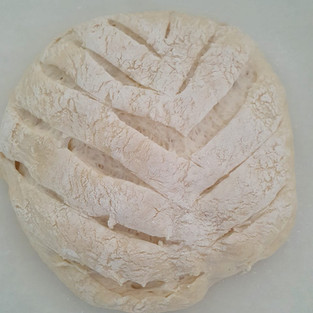This bread is named after my father, who is the ultimate bread man, and never goes a day without eating at least two slices of bread. His favourite is the moody dramatic rye variety, which he used to order from a German baker in Dumaguete, and was shipped frozen to Cebu every week. He taught me to appreciate savoury bread that uses ancient grains and not the Pullman variety (although of course, there's nothing wrong with liking white sandwich bread). When he dropped me off at school in the USA years ago, we enjoyed walking to the neighbourhood bakeries to wolf down loaves of multi-seeded sourdough, rye and pumpernickel fresh from the oven, with steaming mugs of black coffee. That was our thing, while Mom had her hot chocolate or hazelnut latte, a scone, and snuck in an ice cream every chance she got.
Over the course of the pandemic and consequent lockdown, I have made this bread more than 60 times (no joke), and tweaked the recipe and method every so often. The method is based from the popular no-knead bread recipe at NYT Cooking, developed by Jim Lahey of Sullivan Street Bakery, and adapted by Mark Bittman; however, I made some changes by reducing a fraction of the flour measurement, adding rolled oats, different seeds and nuts to the mix, pouring a bit of olive oil in the dough, extending the proof time and cold-proofing the dough overnight in the refrigerator up to 22 hours.
For the leavening agent, I've tried using active dry yeast, starter, levain and instant yeast. Let me briefly summarise the four. Active dry yeast has the shortest lifespan -- once you open the package, you'll need to use it within 3 months or it won't produce bubbles anymore. So it's not so practical to store if you don't make bread as frequently. Homemade starter (a combination of flour and filtered water) can of course give the bread more depth of flavour and is the base of all sourdough bread and byproducts, but it was impractical to feed and monitor it daily. When I had to travel urgently for my mother's vigil and stay in Cebu for 6 weeks, I couldn't bring the starter with me and so I passed it on and used up the remainder. Levain is a portion of the mother starter, mixed with flour and filtered water, that has limited lifespan, as it is used right away in the particular batch of dough that you are working on. I found out that extending the proof time can yield a deeper flavour to the bread too. For practical purposes and because most of us have work, errands, humans and pets to take care of, I recommend using instant yeast for the leavening agent. This allows you to free up your time during proofing to do what you need to do without fretting over whether your leavening is strong enough or if your dough will have enough power to rise.

Baking time: 45 minutes
Preparation time: up to 22 hours
Ingredients:
2 1/2 cups all-purpose flour or bread flour
1/2 cups rolled oats, more for topping
1 tablespoon chia seeds or other seeds such as pumpkin or sunflower seeds
1 tablespoon slivered almonds (other nuts will do too, such as walnut, macadamia or pistachio)
1 teaspoon fine salt or 1.5 teaspoons if coarse salt
2 1/4 teaspoons active dry yeast* or 1 teaspoon instant yeast
1 1/2 cups room temperature or slightly warm water
*Mix active dry yeast with 80 ml warm water and allow to bubble for 5 minutes.
1. Mix flour, rolled oats, chia seeds, almonds and salt. Add yeast. Slowly pour water; do it in increments, not altogether, so the dough doesn't get too wet and sticky. If a bit dry, sprinkle a few more spoonfuls of water.

2. Shape dough into a ball by pulling edges into the centre, turning clockwise and repeating process until it has become a shaggy ball. Seal with cling film or plastic cover, and wrap with dry tea towel. Let it rest for 12 to 18 hours at room temperature. You can also cold proof by leaving it overnight in the refrigerator up to 22 hours.

3. Check dough. It should look stretchy (thanks to the glutens) and bubbly. Oil the sides of the bowl and sprinkle some more flour on the surface. Repeat the pulling clockwise motion until dough becomes a smooth ball.

4. Cut a sheet of parchment or baking paper and lay on work surface. Make sure parchment diameter is at least 3 inches higher than the Dutch oven or the heavy baking pan you are using, for easy pull and transfer before and after baking. Sprinkle some flour at the centre of the parchment. Invert mixing bowl at the centre of parchment paper and gently shake dough to land on parchment. Sprinkle some more flour on top.

Score dough to the center or sides, to allow ventilation and for the bread to expand when baking. If you know how, create leaf patterns or crosses when scoring. Sprinkle some more rolled oats and/or seeds. Cover with cling wrap or tea towel, and bench rest for 1 to 2 hours.

5. Preheat oven to 210 degrees Celsius or 410 degrees Fahrenheit with the covered Dutch oven or baking pan inside, about 20 minutes to half an hour before baking. Once ready, carefully remove Dutch oven using heavy mitts and lay it on the counter. Remove lid. Carefully transfer dough using the sides of the baking paper, and lower into Dutch oven. Cover lid. Put back in oven and heat for 40 to 45 minutes until the top becomes golden brown.

6. At about the 22 to 25 minute mark, carefully remove lid. Continue to bake, uncovered, for another 15 minutes. Allow to cool for 10 minutes before slicing. Serve with olive oil, salt, butter or jam!

Another kind of scoring with a semi-leaf pattern/curved side slashes:








Comments